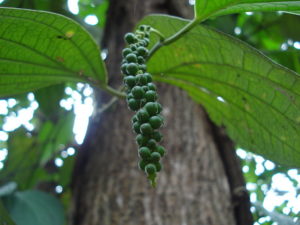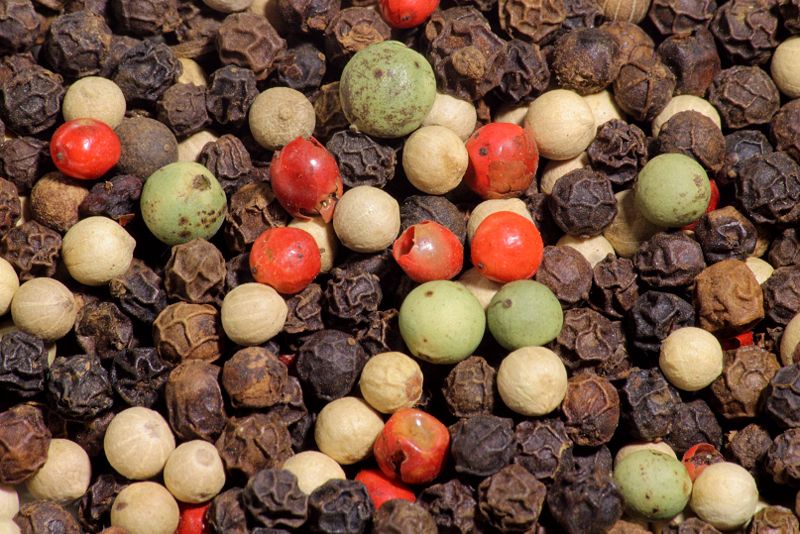Peppercorns, black, green, white and red, are all the dried fruits of the same tropical vine, Piper nigrum. The colors are a result of both the age of the seed and how it is processed, which also affects the taste.
Pepper vines are native to India, but are now cultivated throughout tropical areas of the world. The fruit, peppercorns, have a long history of use, both culinary and medicinal. They have even been used in place of money. Peppercorns spread from Southeast Asia to the Mediterranean. They were used by the Egyptians as part of the embalming process. In Roman times, they were readily available. After the fall of the Roman Empire, peppercorns again became a luxury item only available to the very rich. By the end of the Middle Ages, the price of peppercorns was rapidly falling as European seafarers ventured into Asian waters. In modern times, peppercorns are inexpensive and often paired with salt on our tables.
 Peppercorn vines produce fruits, also known as drupes, in long clusters resembling grapes. They start out green and ripen into red. To get black peppercorns, the fruit is harvested while it is still green and then dried. The green outer skin turns black when dried. Green peppercorns are harvested at the same immature state but instead of being dried, they are pickled, and stay green. For white peppercorns, the fruit is harvested when it is red and fully ripe. The fruit is soaked until the flesh is soft enough to remove. The inner seed, which is white, is then dried. It retains its white color after drying. Red peppercorns are also harvested when the fruit is fully ripe and then pickled, rather than dried. They retain their red color in the pickling process.
Peppercorn vines produce fruits, also known as drupes, in long clusters resembling grapes. They start out green and ripen into red. To get black peppercorns, the fruit is harvested while it is still green and then dried. The green outer skin turns black when dried. Green peppercorns are harvested at the same immature state but instead of being dried, they are pickled, and stay green. For white peppercorns, the fruit is harvested when it is red and fully ripe. The fruit is soaked until the flesh is soft enough to remove. The inner seed, which is white, is then dried. It retains its white color after drying. Red peppercorns are also harvested when the fruit is fully ripe and then pickled, rather than dried. They retain their red color in the pickling process.
Peppercorn vines are woody perennial vines that are hardy in zones 10 and 11. They require both heat and humidity so it is important that you not let your plants dry out. Temperature is also critical. The vines will die below 60⁰F. Even the soil they grow in must be warm, ideally between 75⁰F and 85⁰F. If you live and garden north of zone 10 and grow your vine in a container, keep your container indoors until early summer and be sure to bring it back indoors in the early fall before the nights are cooler than 60F.
Peppercorn vines can be grown indoors because they prefer partial shade conditions. Just be sure to provide it with shade when you bring it outdoors. Indoors, our homes are very dry, so it is a good idea not just to keep it well-watered, but to also mist your vine regularly to provide needed humidity.
Full grown vines reach 12 feet in length so you will need to provide something for it climb on. If you are growing it outdoors, a fence or trellis works well. In containers, you will also need to provide a structure for it to climb in, preferably something that can be transported when you move your vine outdoors for the summer.
You can grow your own peppercorn vines from seed but don’t try using the peppercorns from the grocery store! Those have been dried and are no longer viable. You will need fresh seed or at least seed that is no older than two years. Soak the seeds for 24 hours before sowing. Soaking softens the seed coat leading to better germination. After soaking them, plant the seeds shallowly (⅛-inch deep) and then keep them warm and well-watered until germination in approximately 30 days.
Seedlings should be planted 12- to 15 feet apart if grown outdoors and no more than one vine per container indoors. The vines will begin flowering and producing drupes in about a year.

